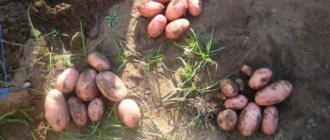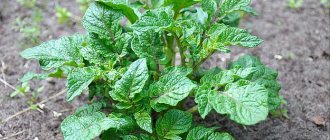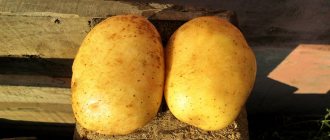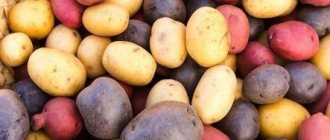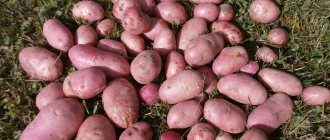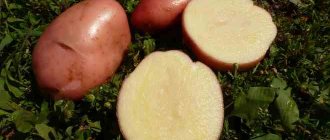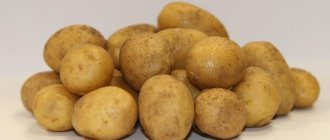A description of the Revanche potato variety, photos and reviews about it will help gardeners decide whether the crop is suitable for planting in a certain region, and what yield they can expect. These potatoes are large-fruited, high-yielding varieties with good taste. Revenge potatoes are planted for commercial purposes and on personal plots.
Pros and cons of the variety
Each potato variety has its own positive qualities. The advantages of the Revenge variety include:
- increased resistance to golden nematode, which can cause significant damage to other varieties. Yield losses due to golden nematode infection can be up to 80%;
- resistance to mechanical damage;
- good transportability;
- long shelf life. In basement conditions, potatoes are stored until the next harvest;
- adaptability to the climatic conditions of the region;
- large weight of tubers;
- good taste and use for preparing any potato dishes.
Dependence of variety selection on climate
Each region of the country has its own climatic characteristics, which have both beneficial and detrimental effects on plants.
The Moscow region does not have the best climate for growing potatoes. Varieties that are resistant to the humidity for which this region is famous are suitable here. This could be Vesna, Zhukovsky early, Timo Khankkiyan (popularly known as simply Timo), Nevsky, Condor, Romano or Lugovskoy. In general, in the Moscow region it is difficult to achieve the desired potato yield, so it is best to plant zoned varieties on the site.
White Spring is an early ripening variety (75-80 days), zoned in the European part of the country and Siberia. Productivity - 320-410 kg per hundred square meters. Disease resistance is average. Due to the short growing season, it is suitable for cultivation in the Arctic. It is possible to obtain two harvests per season. The tubers are light beige, oval, weighing up to 180 grams.
White spring does not require chemical treatment
Timo Hankkiyan is a Finnish variety, unpretentious to the type of soil, with good tolerance to prolonged cold spells, sudden changes in air temperature, excess humidity and drought. It is resistant to viruses and pests. Productivity is from 150 to 300 kg per hundred square meters. The tubers are white, weighing 60–120 grams, tasty, rich in starch, and do not darken during storage.
Timo is distinguished by beautiful white fruits
It should be noted that reviews of Timo among gardeners are extremely mixed. Some people liked it in their gardens, while others claim that its characteristics, including taste, are extremely exaggerated by breeders.
Plant at least three varieties of potatoes on your plot, preferably with different ripening times. This will significantly reduce your likelihood of being left without a harvest. Proper care is key to growing potatoes that are not weeds and will not grow on their own.
The choice of Leningrad gardeners is early and medium varieties. Their first harvest takes place in July.
Nadezhda is an early variety, unsightly for the Colorado potato beetle. Unpretentious to grow. Suitable for central Russia and the Urals. The maximum yield threshold is 416 kg per hundred square meters. Delicious yellow fruits, weighing 90–160 grams.
Nadezhda is resistant to the Colorado potato beetle
Latona is a Dutch unpretentious variety that tolerates both drought and heavy rains. The fruits are yellow, oval-round, weighing 90-140 grams, excellent taste, with a high starch content.
Latona tolerates both high humidity and drought well
Of the mid-late varieties, Eliseevsky, Lena, Volosovsky, Krinitsa, Rosinka grow well here, which are not at all afraid of late blight and the Colorado potato beetle.
The Central Black Earth Region has very good climatic conditions for growing any potatoes.
The most common varieties are:
- early - Vineta, Zhukovsky early, Krepysh, Latona, Neptune, Rosara, Bullfinch, Luck;
- mid-early - Archidea, Zekura, Condor, Crown, Lakomka, Nevsky, Odysseus, Ramos, Sorcerer;
- mid-season - Aspiya, Zhivitsa, Lugovskoy, Olimp, Resurs, Sokolsky;
- late ones - Belorussky 3, Golubizna, Lasunak, Lorch, Naroch, Picasso, Pobeda, Temp.
Siberia and the Urals are areas of risky farming. Not every potato variety can adapt to their climatic conditions. Short summers, frequent cold spells, sudden changes in intense heat with rain and cold nights. Alena, Priekulsky, Udacha, Zhukovsky early, White Spring were able to take root in this climate. Late varieties of potatoes are not planted in the Urals and Siberia.
Popular among the early
Governor is an early ripening variety that is completely undemanding to soil and climate. Productivity - up to 700 kg per hundred square meters. Resistant to most diseases and can be stored for a long time. The fruits are red with white pulp.
Governor—high-yielding variety
Lyubava - yield - up to 400 kg per hundred square meters, unpretentious variety, resistant to cancer pathogens. Affected by golden nematode. Red, round-oval fruits weighing 110-210 grams.
Lyubava is unpretentious in cultivation
Mid-early in the Urals
Among the mid-early varieties, such varieties as Korona, Lukyanovsky, Effect, Aspiya, etc. are popular in the Urals. These varieties have high yields (up to 450 kg) and good resistance to adverse weather conditions.
Universal varieties
Among the universal ones in the Urals, the most common variety is Sante - mid-early (80-90 days), with large oval yellow fruits, with a high starch content and a yield of 400 kg per hundred square meters.
Planting and caring for Revenge potatoes
The Revanche variety is suitable for growing in open ground and in greenhouse conditions. To obtain a high yield, it is necessary to adhere to the rules of agricultural technology.
Selection and preparation of a landing site
Revenge potatoes prefer sunny areas, so beds are chosen in the south, southeast or southwest. Lowlands where water accumulates are not suitable for growing potatoes. Clay soils do not allow achieving good yields. The best option is light sandy loam soil with a loose composition, black soil or peat soil.
If the site is located on clay soil, the situation can be corrected by adding sand, wood ash, manure, and humus to the soil.
In the spring, before planting Revanche potatoes, the soil must be loosened. If the soil is good (sandy loam), it is enough to loosen it by 15–20 cm. For clay soil, it is recommended to carry out two-time treatment. First, slight loosening is performed to a depth of 15 cm; when planting, the area is dug up to the depth of a spade bayonet, and the lumps are leveled with a rake. This helps eliminate excess moisture in the area and saturate the soil with oxygen.
Predecessors in the garden bed where it is planned to plant potatoes can be: cabbage, cucumbers, beans, sorrel, lettuce, spinach.
Preparation of planting material
If potatoes are planted with seeds, they are pre-soaked in water for 48 hours. You can use the seed hardening method. To do this, soaked seeds are placed in the refrigerator overnight, and during the day they are pulled out and kept indoors at room temperature. The hardening process takes ten days.
Tubers are prepared using various methods:
- Germination is the most effective method, accelerating the formation of new tubers and increasing yield. Dry germination is carried out in boxes, the process takes about 30 days. During wet germination, Revanche potatoes are placed in boxes with wet peat or sawdust. The advantages of this method are that the preparatory period is reduced to 15–20 days;
- The wilting method is used if there is little time before planting potatoes in the ground. The tubers are kept warm for 7–10 days;
- Potatoes can be warmed up 3-4 days before planting. This is done gradually, for the first 1–2 days the tubers are kept at a temperature of +15 °C, then the potatoes are transferred to a warmer room (+20 °C).
Landing rules
If planting is carried out with seeds, then they are sown at the end of March or at the beginning of April. The boxes are filled with a damp mixture consisting of soil and peat in a ratio of 1:4. Seedlings are planted in rows. The distance between adjacent seeds should be 5 cm, and between rows - 10 cm. The sprouted seeds are covered with sand, the layer should be no more than 0.5 cm. Boxes with seedlings are covered with film or glass and transferred to a warm room, you can use a greenhouse. The first shoots appear after about 7–10 days. After two true leaves appear on the stem, the seedlings are planted in peat or plastic cups.
The seedlings are watered and the soil is loosened. After the threat of frost has passed, the seedlings are planted in the beds. Wells are prepared for this:
- the depth of the hole is about 10 cm;
- humus is added to the bottom - 300 g;
- pour 0.5 liters of water.
The seedlings are deepened so that the top with three leaves appears on the surface.
If day and night temperatures differ significantly, Revanche potato seedlings are covered with film. After warm nights set in, the shelter is removed.
If potatoes are planted as tubers, the soil temperature should be at least 10 °C. The deepening of potatoes depends on the soil:
- on sandy loam and fertile soils, the tubers are buried 10–11 cm;
- if the soil is clayey, the depression should not exceed 8 cm;
- in the southern arid regions, the tubers are laid to a depth of 12 to 15 cm.
The recommended planting pattern is 30x60 cm.
Watering and fertilizing
The frequency of watering depends on the weather in the region and the quality of the soil. Sandy soils dry out faster, so more frequent watering is required. Potatoes of the Revanche variety are a moisture-loving crop that suffers from a lack of moisture. The minimum number of waterings per season is 3 times:
- after germination, the soil must be moistened;
- The second time watering is carried out during the appearance of buds;
- After the flowering process is completed, the plant is watered again.
Approximate water consumption per 1 m² is 50 l. The water should be warm (+23 ÷ +25 °C). To avoid increased evaporation of moisture, watering is carried out in the morning or evening hours.
If the summer is dry, Revanche potatoes need additional watering. It can be carried out in furrows; the drip moistening system is effective. Sprinkling can harm bushes, since a humid environment promotes the development of fungal diseases.
To increase potato yields, fertilizers are used. They are carried out three times per season:
- 20–30 days after planting, use a mixture of urea and mullein. Mullein or bird droppings are added to water (1:4) and kept for 7 days. Add a solution of litter and 1 tbsp to 1 bucket of water. l. urea. 0.5 liters of nutrient composition is poured under each bush;
- When buds appear on potatoes, fertilizing with wood ash and potassium sulfate is necessary. For a bucket of water you will need 1 cup of wood ash and 1 tbsp. l. potassium fertilizer. 500 ml of solution is poured under the bush;
- After the potatoes have bloomed, apply another fertilizer. To 10 liters of water add 200 ml of mullein and 2 tbsp. l. superphosphate. Consumption – 0.5 liters for each bush.
You can use additional fertilizers. To prepare nettle infusion, you will need a bucket of water, crushed nettle shoots and leaves, wood ash (1 cup), yeast - 50 g. After a week of fermentation, the composition is diluted with water (1:10) and the tops are sprayed.
Loosening and weeding
A week after planting potatoes of the Revanche variety, the first weeding of weeds in the garden bed is carried out. Loosening done during the daytime helps eliminate about 80% of emerging weeds.
Loose soil is necessary for the full development of tubers. After rains, the earth becomes compacted, so it is recommended to loosen the soil after rainfall.
Hilling
The first hilling is carried out after the shoots have stretched up to 15 cm. The procedure is performed as necessary, but at least 2 times per season. The second hilling is carried out approximately two weeks after the first, the potatoes should not yet bloom. Additional hilling may be required if the potatoes are protruding from the ground. Tubers must be covered with a layer of soil.
Potato variety "Lada f1"
Potatoes of the Lada f1 variety are mid-early and form a harvest of high-quality tubers in 70-75 days. The variety is characterized by stable and high yields and is suitable for cultivation in almost any region of Russia.
Description and advantages of the variety
The bushes are characterized by average growth power. The tubers are covered with a whitish or light yellow smooth skin. Potatoes are round-oval, with superficial sparse eyes. The pulp when cut is whitish-yellow, with high levels of starchiness.
The taste of Lada f1 potatoes is excellent. In addition, the variety is characterized by fairly high resistance to viral diseases, as well as bacterial infections. The advantage of potatoes is their excellent consumer and commercial qualities.
Cultivation is allowed both by sowing soaked and hatched seeds, and by planting seed potato tubers.
Landing rules
Seed potatoes should be removed from storage about a month and a half before planting
It is very important to carry out preventive treatment of tubers against major diseases and pests, as well as to carry out germination of tubers in the light and landscaping. The preparation “Prestige” has proven itself well for pre-planting treatment of potatoes.
A well-lit area should be allocated for planting, without shallow groundwater and without the risk of flooding in the spring. The soil should be loose and fertile, with sufficient nutrients. Planting is carried out after the soil has warmed to a depth of 10 cm or more.
Technology of growing from seeds
To grow the highest quality and richest potato harvest from seeds, you should first soak the planting material in warm water. Special solutions of microelements that can be added to water have a very good effect.
After soaking, potato seeds must be sown in pre-prepared planting containers. The standard sowing pattern is 5 × 10 cm. A distance of 5 cm between plants and 10 cm between rows allows the potatoes to provide optimal feeding area. Three weeks after sowing, seedlings should be fed with nitrogen-containing fertilizers.
About a month and a half after sowing, the plants need to be hardened off and planted in a previously prepared area in open ground. High-quality potato seedlings are plants 15 cm high and have 5 or 6 true leaves. It should be planted after the threat of spring return frosts has passed. Further care for plants planted in open ground consists of watering, regular weeding, loosening the soil and fertilizing.
Diseases and pests
The most common and dangerous pest of various potato varieties is the Colorado potato beetle. The offspring of just one pair of insects can ruin up to 4 hectares of potato plantings. In small areas, it is recommended to collect beetles and larvae manually, but on an industrial scale, treatment is carried out with chemical and biological preparations.
Insects that damage potato tubers are wireworms, darkling beetles, and click beetle larvae. They not only spoil the tubers with their moves, but also spread rot pathogens. Control measures include crop rotation. In the beds after potatoes, it is recommended to plant legumes that are not affected by these insects.
To combat mole crickets in garden beds, deep plowing and loosening of the soil are used. In the spring, before digging, you can spread bait poisoned with chemicals on the site.
Viral diseases (wrinkled mosaic, mottling, gothic) lead to potato degeneration. The disease can be carried by insects - aphids, cicadas. Sick bushes must be destroyed.
Bacterial diseases - rot, black leg cannot be treated. Sick plants are dug up and burned.
A site about the garden, cottage and indoor plants.
Renewing potato planting material is the most pressing topic among gardeners, and everyone solves it in their own way. And it sometimes happens that this solution can surprise even the “inventor” with its simplicity.
It would be a sin not to share such a discovery.
I heard a lot about the degeneration of potatoes from friends, but I naively believed that for some reason this trouble should bypass me.
Apparently, I was confused by the constant yield of the variety being grown, which was listed everywhere as elite. And since he has such an honorary title, it’s no accident.
EVERYTHING YOU NEED FOR THIS ARTICLE IS HERE >>>
But one day, after planting 25 buckets of potatoes, I dug up only 50 (including change). That’s when I realized that my planting material had come to an end.
I started looking for something to replace it with. At first I took potatoes for planting from friends, girlfriends and parents.
The result was not bad, but I felt like some kind of beggar: why am I, an adult, not worthy of learning how to grow potatoes?
I went to the store and bought two varieties of potatoes for 70 rubles per 1 kg. I came home, looked, calculated and realized that with this method of updating planting material, I would soon go down the drain.
Then, having seen potato seeds at the fair, I decided to try growing them from seeds. Of all the products offered, I focused my attention on the mid-season, high-yielding potato variety Revenge .
Harvesting and storage
The ripening period for potatoes of the Revanche variety takes from 90 to 110 days, it all depends on the region and climatic conditions. Harvesting is carried out after the tops have dried, when the location of the bushes can still be determined.
Potatoes are harvested in dry weather and allowed to air dry in the shade of trees. Then they are only transferred to basements or cool storage areas.
For the first two weeks, potatoes are stored at a temperature of about 18 °C, then the temperature is lowered to 12 °C, after 10 days the temperature is set in the range from 2 to 5 °C. Under such conditions, potatoes of the Revanche variety can be stored until spring.
Potatoes Red Fantasy variety description
| Variety name | Red fantasy |
| general characteristics | table variety with fruits of excellent taste, suitable for baby and dietary food |
| Maturation period | 90-110 days |
| Starch content | 13-21% |
| Weight of marketable tubers | 90-140 gr |
| Number of tubers in a bush | 10-12 pcs |
| Productivity | 260-380 c/ha |
| Consumer qualities | good taste, slightly overcooked |
| Keeping quality | 95% |
| Peel color | pink |
| Flesh color | dark yellow |
| Preferred Growing Regions | Central, Volgo-Vyatsky |
| Disease resistance | resistant to potato blight, golden cyst nematode, common scab, blackleg, leafroll or tobacco mosaic viruses |
| Features of cultivation | drip irrigation system recommended |
| Originator | Europlant (Germany) |
- large tubers, weighing from 90 to 140 g;
- oval shape, slightly elongated;
- the tubers are smooth and neat;
- the peel is red, evenly colored, moderately thin;
- eyes few, shallow, very small;
- the pulp is dark yellow when cut;
- starch content ranges from 13.5 to 21.5%;
- high content of protein, amino acids, carotene.
In the table below you will see indicators such as starch content and tuber weight for different potato varieties:
| Variety name | Starch content (%) | Average weight of tubers (g) |
| Red Fantasy | 13-21 | 90-140 |
| Aurora | 13-17 | 90-130 |
| belongings | 12-17 | 150-200 |
| Rowanushka | 11-18 | 90-130 |
| Blue | 17-19 | 90-110 |
| Zhuravinka | 14-19 | 90-160 |
| Lasunok | 15-22 | 150-200 |
| Sorcerer | 13-15 | 75-150 |
| Granada | 10-17 | 80-100 |

